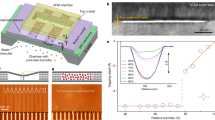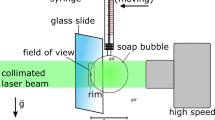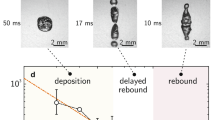Abstract
THE mechanism of capillary rise in a random sphere packing is such that, depending on the absolute value of the wetting- or contact-angle, θ, at equilibrium either a saturation gradient, widest for θ = 0, is observed, or a sharp front between the saturated and the dry part of the porous medium, above some critical value of θ (ref. 1). We present here another partition in the phenomenological description of capillary rise for systems which have θ>0. There are systems in which θ remains constant and others in which θ decreases during capillary rise. In particular, attention is drawn to an uncommon hypothesis that can explain a decrease in θ. Given the nature of the absorption isotherm in the neighbourhood of saturation, small variations in vapour pressure may induce discontinuous film thickness jumps on a microscopic scale, which may display itself macroscopically as a changing contact angle.
This is a preview of subscription content, access via your institution
Access options
Subscribe to this journal
Receive 51 print issues and online access
$199.00 per year
only $3.90 per issue
Buy this article
- Purchase on Springer Link
- Instant access to full article PDF
Prices may be subject to local taxes which are calculated during checkout
Similar content being viewed by others
References
van Brakel, J. & Heertjes, P. M. Nature 254, 585 (1975).
van Brakel, J. & Heertjes, P. M. Powder Technol. 9, 263 (1974).
van Brakel, J. Powder Technol. 11, 205 (1975).
van Brakel, J. & Heertjes, P. M. Powder Technol. 16, 75, 83, 91 (1977).
van Brakel, J. & Heertjes, P. M. Proc. Levich Anniverasry Conf. on Phys. Chem. Hydrodynamics (Hemisphere, Washington, in the press).
Freundlich, H. Kapillarchemie, (Akademische Verl. Leipzig, 1922).
Deryagin, B. V. (Ed.) Research in Surface Forces, 3 (Consultants Bureau, New York, 1971). Padday, J. F. Special Disc. Faraday Soc. 1, 64 (1970). Dzyaloshinskii, I. E. Lifshitz, E. M. & Pitaevskii, L. P. Adv. Phys. 10, 16 (1961).
Bangham, D. H. & Saweris, Z. Trans. Faraday Soc. 34, 554 (1938). Bangham, D. H., Mosallam, S. & Saweris, Z. Nature 140, 237 (1937). Bangham, D. H. & Razouk, R. I. Trans. Faraday Soc. 33, 1459 (1937).
Hardy, W. B. Phil. Mag. 38, 49 (1919).
Author information
Authors and Affiliations
Rights and permissions
About this article
Cite this article
VAN BRAKEL, J., HEERTJES, P. Contact angle and film jumps. Nature 268, 44–45 (1977). https://doi.org/10.1038/268044a0
Received:
Accepted:
Published:
Issue Date:
DOI: https://doi.org/10.1038/268044a0
Comments
By submitting a comment you agree to abide by our Terms and Community Guidelines. If you find something abusive or that does not comply with our terms or guidelines please flag it as inappropriate.



